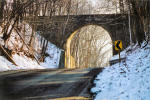|
This year's list includes an early
cast-concrete bridge, an African-American fraternal lodge, a rare
above-ground public swimming pool, two school buildings, a women's
club building, a Tudor Revival-style streetscape, and the home and
studio of a notable architect.
The purpose of the list is to focus
attention on sites threatened by deterioration, lack of maintenance,
insufficient funds, inappropriate development or insensitive public
policy. Since the first list was issued in 1995, over 100 properties
have been identified on the endangered list, calling attention to
statewide resources in need of preservation. The status of the
listed properties is as follows: 28 buildings have been saved, 15
buildings have been demolished and 59 buildings still remain
threatened to some degree.
The
Landmarks Preservation
Council of Illinois is celebrating its 34th
year as a statewide advocacy and education organization. The
council works with citizens and communities throughout Illinois to
preserve threatened historic resources, provides financial
assistance through its Preservation Heritage Fund and protects
historic places by accepting easement donations. In addition to its
Ten Most Endangered list, the council also sponsors the Chicagoland
Watch List, the annual Illinois Historic Preservation Conference and
the Driehaus Foundation Preservation Awards.
The complete list, including photos
of the following sites, is available at
www.landmarks.org
through the "Press Room" link. Descriptions follow:
[Click on headings for photos.]
Gillett
Memorial Arch
County Road 10, Elkhart,
Logan County
 Commissioned by former Illinois
first lady Emma Gillett Oglesby in 1915 as a memorial to her
brother, this cast-concrete bridge serves as a link between the
family cemetery and the grounds of the historic estate. Located 20
miles north of Springfield, the single-arch bridge is a unique
visual feature along a scenic stretch of roadway. Over the years,
family members and local residents have made efforts to maintain the
bridge, which shows only minimal signs of wear. Despite its historic
association, the 90-year-old bridge is not protected by local
landmark designation. The county's engineer has stated his intention
to demolish the bridge in order to widen the road at this location. Commissioned by former Illinois
first lady Emma Gillett Oglesby in 1915 as a memorial to her
brother, this cast-concrete bridge serves as a link between the
family cemetery and the grounds of the historic estate. Located 20
miles north of Springfield, the single-arch bridge is a unique
visual feature along a scenic stretch of roadway. Over the years,
family members and local residents have made efforts to maintain the
bridge, which shows only minimal signs of wear. Despite its historic
association, the 90-year-old bridge is not protected by local
landmark designation. The county's engineer has stated his intention
to demolish the bridge in order to widen the road at this location.
Jewelers Row
District
21-35 S. Wabash Ave.,
Chicago, Cook County
Three low-rise loft buildings,
constructed during the 1870s, were recently placed on the market for
redevelopment by the Art Institute of Chicago. Even though they are
located within a local landmark district, a prospective new owner
has announced plans to construct a 67-story residential tower with a
slight setback from the original five- and six-story facades. The
height of the tower would have a negative effect on the character of
the Jewelers Row District, as well as on the historic appearance of
the adjacent Michigan Avenue "streetwall," which faces Grant Park
and Lake Michigan.

Lincoln Hall
702 S. Wright St., Urbana,
Champaign County
The main quadrangle at the
University of Illinois at Urbana-Champaign is surrounded by Georgian
Revival and neoclassical-style academic halls built in accordance
with a 1905 master plan. Lincoln Hall, which was constructed from
1911-1929, is a 3½-story Renaissance Revival-style building situated
in the southwest corner of the quad. The university's historic
preservation plan named it the fifth most significant structure on
campus. However, current expansion plans call for alterations to the
building's rear façade, facing the street, and a substantial amount
of interior demolition, affecting portions of the central
auditorium. This expansion project also points to the failure of a
system of design review between the university and the Illinois
Historic Preservation Agency.
Old Lincoln
School
2125 Seventh Ave., Rock Island, Rock Island
County
This Richardsonian Romanesque
building was designed by architect Edward S. Hammatt as Public
School 4. It opened its doors in 1894 as a grade school for the
Greenbush neighborhood, later known as the Broadway neighborhood.
The school closed in 1980 and was threatened with demolition four
years later, before it was saved through local landmark designation.
A subsequent private owner has allowed the property to stand vacant
for 20 years. The city hopes to acquire the building through eminent
domain proceedings and to seek a developer who will rehabilitate the
long-vacant structure.
River Forest
Women's Club
526 Ashland Ave., River Forest, Cook County
This dark green board-and-batten
Prairie-style building was designed in 1913 by William Drummond, the
chief draftsman of architect Frank Lloyd Wright. Drummond's wife was
an early member of the private social club that has operated the
building for more than 90 years. In recent years, club membership
has waned and the costs of ongoing maintenance have become a serious
financial burden. The clubhouse, which was built on an oversized
lot, is surrounded by single family residences. The community does
not have a local preservation ordinance and, unless a sensitive new
owner is identified, the lot could be cleared and subdivided for
residential development.
Tuscan Lodge
201 N. Washington St., Carbondale, Jackson County
Upon completion in 1894 as an
Oddfellows Hall, this structure was deemed "an ornament to the city
and one of the most substantial business blocks." The building,
prominently situated on a corner of the town square, was purchased
in 1903 by Tuscan Lodge 44, an African-American Masonic Order that
made it a community center for more than a century. During the years
of racial segregation, this building hosted musical concerts by Cab
Calloway, Miles Davis and Duke Ellington. The ill effects of
deferred maintenance, however, forced the Masons to vacate the
property eight years ago. While the group continues to seek funding
for rehabilitation, the lodge's condition has grown progressively
worse. The city is obligated to monitor the property for potential
condemnation. The local historic preservation commission, however,
supports restoration.
[to top of second column in this article] |

Universalist
Unitarian Church
908 Hamilton Blvd., Peoria,
Peoria County
This neoclassical-style church,
built in 1911, is located adjacent to the downtown medical district.
Last year, the congregation sold the church to the medical center
and relocated to a new facility. The church is not protected as a
local landmark, and the new owner plans to demolish the structure to
make way for new construction. The medical center has offered to
donate the building to someone who will move it to another location
by Aug. 1.

Veterans
Memorial Pool
251 Custer Ave., Dixon, Lee
County
Only a handful of these above-ground
pools, which were based on plans by architect Wesley Bintz, remain
throughout the United States. These pools feature a raised patio
overlooking the central pool basin, plus integrated bathhouses on
the ground floor. This pool, completed in 1950, also includes a
two-tier diving platform. It was dedicated by local native and
then-Hollywood actor Ronald Reagan in memory of war veterans. The
Dixon Park District closed the pool five years ago, citing
maintenance costs. The park district has no plans to reopen the
pool, which could become subject to demolition by neglect.
Westgate
Street
1100 block of Westgate
Street, Oak Park, Cook County
This "streetcar suburb" retail
district is threatened by a new downtown master plan. Its six
commercial buildings, located one block from a transit station, were
built in 1925- 1931. The architect Paul Desmond designed them in a
Tudor Revival style reminiscent of an English village. Although the
street has been declared eligible for the National Register of
Historic Places, it is not protected from alterations or demolition.
The proposed master plan calls for a new cross-street to slice
through the middle of the block, which would result in the
demolition of most of the historic structures.
Zook Home
and Studio
327 S. Oak St., Hinsdale,
DuPage County
Architect R. Harold Zook designed
this residence for his family in 1924. The modest two-bedroom house
has an adjacent garage and second-floor studio where Zook worked on
his architectural commissions. The intricately patterned brick and
stone house bears the picturesque details of an English Cotswold
cottage, including steep gables, leaded diamond-pattern casement
windows and a wood shingle roof, shaped in an undulating style that
wraps the eaves to mimic a traditional thatched roof. In the past 10
years, seven Zook-designed residences in Hinsdale have been
demolished as part of the village's trend of tear-down development.
This property was recently purchased by a local builder who plans to
raze both buildings and construct a large-scale modern mansion in
their place. Zook's later Art Deco designs include the Municipal
Building in St. Charles and the Pickwick Theatre in Park Ridge, both
listed on the National Register of Historic Places.

Cook County
Hospital -- a special
11th designation
1835 W. Harrison St., Chicago, Cook County
Although this building has appeared
on the top-10 list on three occasions (2001, 2003, and 2004), the
jury felt it again merited special recognition due to the ongoing
public debate over its future. The two-block-long structure, dating
to 1913-16, was designed by Paul Gerhardt and Richard Schmidt. In
addition to its impressive beaux-arts-style façade, the building's
history includes numerous medical advances, including the first
blood bank, indigent care and modern emergency room procedures. The
building was vacated in late 2002 and was scheduled to be demolished
until advocacy efforts convinced the Cook County Board to delay
demolition. Its fate, however, remains uncertain.
Judging for this year's Ten Most
Endangered Historic Places list took place in February. The jury
members were Richard Betts, an architectural historian from
Champaign; Michael Fus, Chicago Park District; Sidney Robinson,
University of Illinois-Chicago; Ellen Stoner, AltusWorks Inc.,
Chicago; Martin Tangora, Landmarks Preservation Council of Illinois
board member, Chicago; and Michael Waldinger, Illinois Chapter of
the American Institute of Architects, Springfield.
[Landmarks
Preservation Council of Illinois news release]
 |

